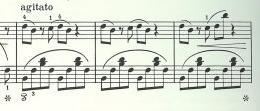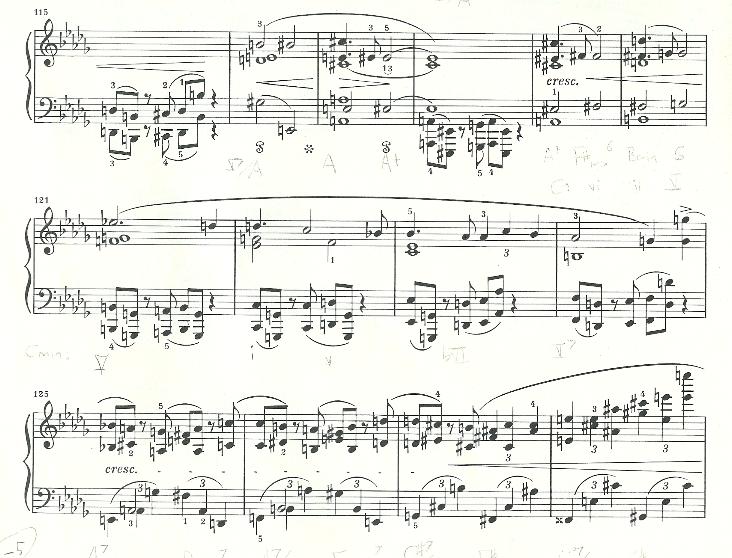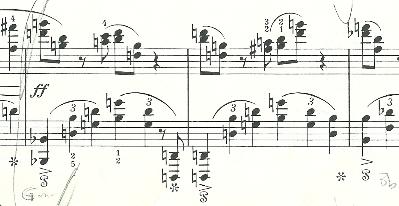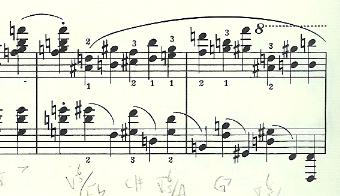31 July 2006
Chopin, Piano Sonata No. 2, Op. 35, in B-flat minor, 1st Movement, Development
The development lasts from measure 105 through measure 168 and is dominated by the rhythmic signature of the movement's first theme (shown below where it first enters at measures 9-11) played within varying harmonic progressions.

The movement as a whole, I realized, can be looked at as more of a compound binary form in ABAB than rigidly a sonata form. The first AB (in B-flat minor then the relative D-flat major) describes the two themes presented in the exposition, the next A describes the dramatic presentation of the first theme within the development, and the final B (in the parallel B-flat major) is the sostenuto return of the second theme. This is a nod to the history and origins of sonata form, but also manifests--as Charles Rosen emphasizes in his book The Classical Style--the very mutable nature of sonata form.
The development runs organically through five short episodes. The first, running from measure 105 through measure 120, begins the "conversation" between the two themes that I had mentioned in my previous entry on the movement's exposition. The second theme is only hinted at by ascending half-notes in the soprano, but in the second episode, measures 121 through 136, it is quoted in full phrases while the first theme pulses beneath in the left hand. The 16-measures of the second episode are divided into four measures of the second theme, four of the first, four of the second, and four of the first. Below are measures 115 through 128, consisting of the last six measures of the first episode and the first half of the second episode:

Harmonies in the first episode move up scale steps from F-sharp min to G maj to A maj to B min. B then becomes a pivot tone (of sorts) and becomes the third of the G7 in C min.
Just as the ascending half-notes in measures 116-117 and 119-120 seed the introduction of the second theme in measures 121-124, the four-against-three agitation in measures 125-128 seeds the rhythmic pattern for the development's third episode, stretching from measure 137 through 152. Here are the first two measures of the pattern that is repeated throughout the third episode:

The chords change every two measures and can be grouped every four: (G min, B-flat min), (F min, A-flat aug), (E min, G maj), (D maj D min, F maj), this time moving down scale steps. The fourth episode repeats a four-measure phrase twice from measure 153 through 160. It varies in rhythm slightly from the third episode by replacing the bass quarter-note triplets with open-voiced eighth-note arpeggios. Harmonically, it remains almost throughout on a C-flat maj chord.
The fifth and final episode acts as a bridge back to the second theme (the recapitulation). It is marked with a stretto immediately after a fortissimo and should be considered as paired with the ritenuto that opened the development section in measure 105. The music is all quarter-note triplets and acts as a pedal point on a dominant F approaching the B-flat maj recapitulation. With the triplet motion and the interspersed C7s acting as V/Vs, this section very much resembles the first coda of the exposition with its I V/V V I progression. This section even closes with a chromatic passage outlining the vii7 of B-flat similar to the octatonic passge at the end of the exposition's first coda outlining the vii7 of C:

And in the development:

Although the melodic second theme is present in the development, it is still very much the territory primarily of the rhythmic first theme. Here's a summary of the five episodes:
- 105-120, first theme in the bass with second theme hinted at in the soprano, step-wise ascending harmonies
- 121-136, alternate phrases containing the second theme with phrases containing the first presented in four-against-three rhythm, dominant harmonies,
- 137-152, four-against-three rhythm persists across step-wise descending harmonies,
- 153-160, fast four-against-four crescendo with sustained C-flat maj harmony,
- 161-168, F7 pedal point referencing the first coda of the exposition
- Exposition - 4 May 2006
- Where was I? - 15 April 2006, begin practicing
- Chopin list - 26 May 2005, order received!
- Sheet music purchase - 11 May 2005, ordered sonata from Sheet Music Plus
- Piano fingering for diminished scales - 7 March 2005, fingering for practicing octatonic/diminished scales
- The vinyl and the concert posted by sstrader on 21 May 2016 at 1:59:26 PM
- Rod McKuen posted by sstrader on 22 March 2016 at 8:58:35 PM
- More political transcriptions posted by sstrader on 20 March 2016 at 10:19:06 AM
- Notes on We Don't Care About Music Anyway posted by sstrader on 7 June 2015 at 1:06:34 PM
- Ives Concord Sonata posted by sstrader on 13 February 2015 at 5:13:17 PM